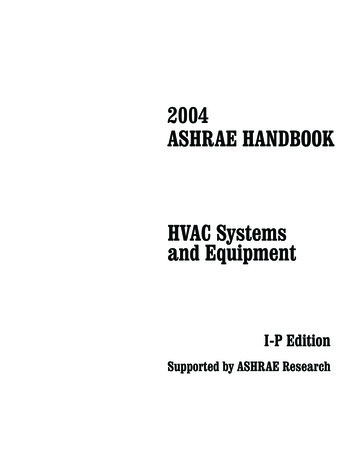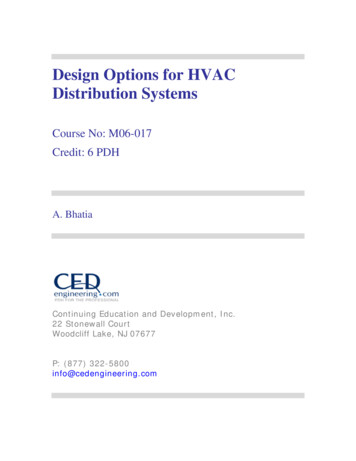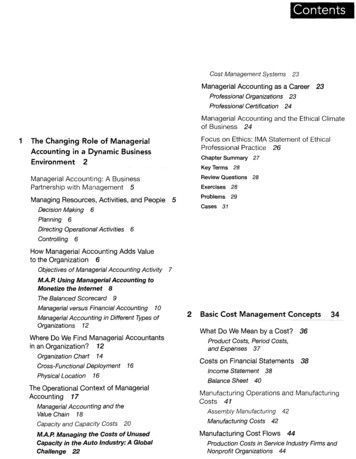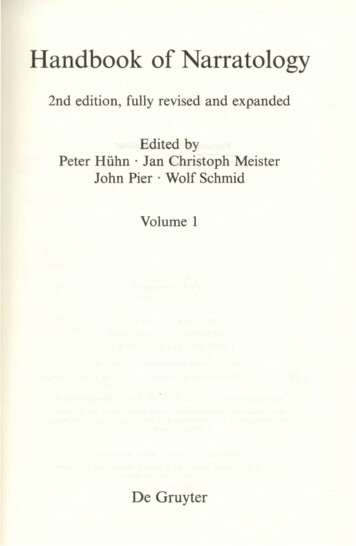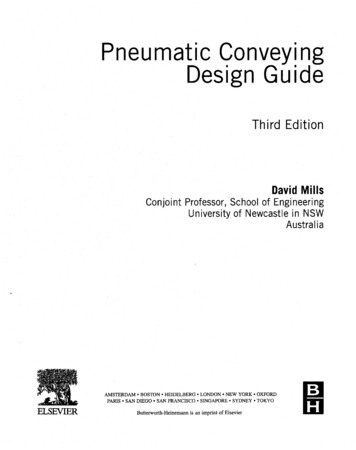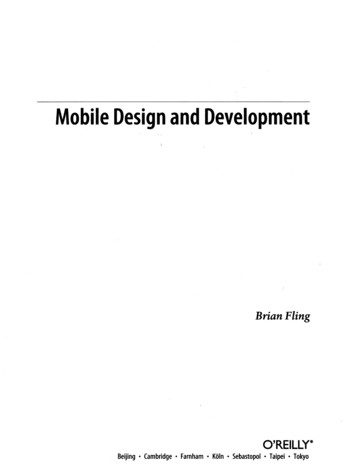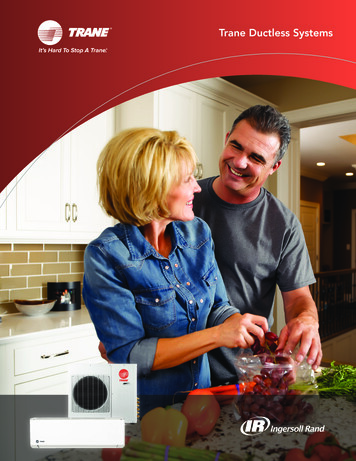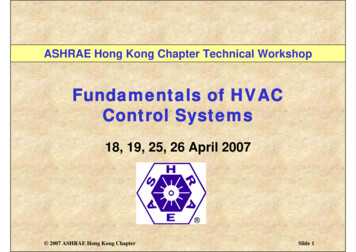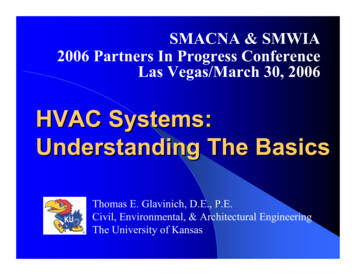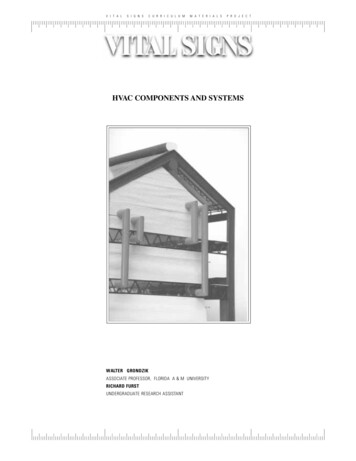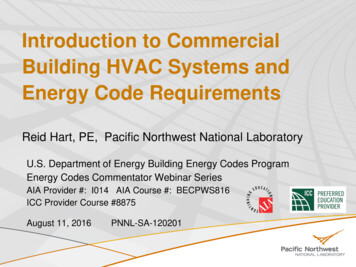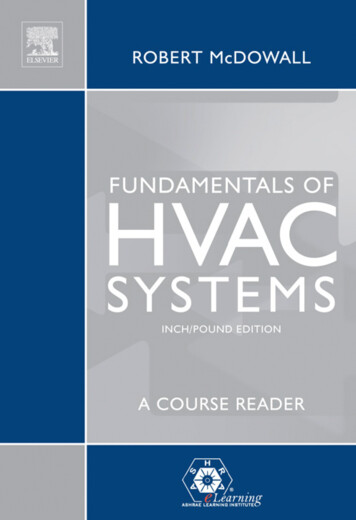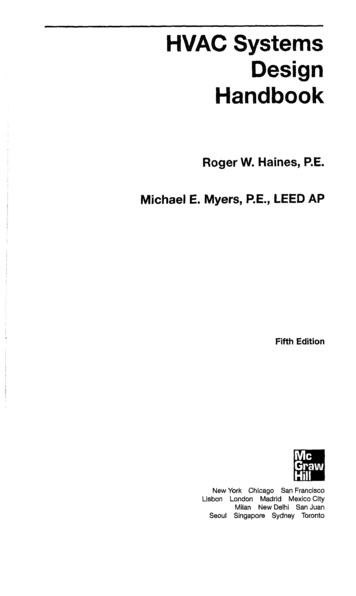
Transcription
HVACSystemsDesignHandbookRoger W. Haines, P.E.Michael E. Myers, P.E., LEED APFifth EditionMcGrawHillNew YorkLisbonChicagoLondonMilanSeoulSan FranciscoMadridMexicoNew DelhiSingaporeSydneyCitySan JuanToronto
ter1.11.xiiiHVACEngineering Equations for DailyUse1"IIntroductionPart 1-Frequently Used HVACEquations31.2Air Side1.3Fan Laws61.4Heat Transfer Equations71.5Fluid Handling1.6Power and1.71.81.91.10Equations8EnergySteam EquationsPart 2-lnfrequentlyAir Side EquationsFluid HandlingSmoke ManagementChapter 2.1011Used HVAC EquationsHVAC Engineering Fundamentals: Part 1121516212.1Introduction212.2Problem Solving212.3Value222.4EngineeringCodes, Regulations and2.5Fluid Mechanics2.6Thermodynamics232.7Heat Transfer242.8Psychrometrics252.9Sound and Vibration252.10Energy Conservation252.11Summary25Chapter3.StandardsHVAC Engineering Fundamentals: Part 22323273.1Introduction273.2Comfort27iii
ivContents3.3HVAC3.4Control Strategies293.5Architectural, Structural and Electrical ConsiderationsConceptual DesignEnvironmental Criteria for Typical BuildingsDesigning for Operation and Maintenance29Codes and Standards34Summary343.63.73.83. 93.10Chapter 4.Procedures: Part 1Design—Load Calculations303033374.1Introduction374.2Use of Computers384.3Rule of Thumb Calculations384.4Design Criteria and Documentation Forms394.5Factors for Load Components454.6Load Calculations794.7Dynamic4.8Ventilation Loads864.9Other Loads87Summary884.10Chapter 5.for28Cyclesversus Static Load Calculations86Design Procedures: Part 2—General stainable Systems and895.4EquipmentMaintainability of Systems and EquipmentCriteria for System and Equipment Selection5.5Options in System and Equipment Selection5.6The5.7Effects of Altitude and pter 6.PsychrometricChart909097100Equipment Selection105Procedures: Part 3—Air Handling SystemsDesign1076.1Introduction1076.2Fans1076.3Air Duct6.4Registers and ir Distribution with6.9Stratification1526.10Noise Control1546.11Indoor Air 7HighFlow RatesProcedures: Part 4—Fluid Handling Systems1481577.1Introduction1577.2Steam157
Contentsv7.3Water1657.4High-Temperature Water1677.5Secondary Coolants (Brines and Glycols)1677.6Piping er 8.Design196Distribution205Procedures: Part 5-Central Plants2078.1Introduction2078.2General Plant Design ConceptsCentral Steam Plants2072108.6Low-Temperature Hot Water Central PlantsHigh-Temperature Hot Water Central PlantsFuel Options and Alternate Fuels8.7Central Chilled Water Plants2148.8Thermal Storage SystemsCentral Plant Distribution ation Plants2258.11Summary230Chapter 9.DesignProcedures: Part 6—Automatic Controls2319.1Introduction2319.2Control Fundamentals2329.3Control Devices2379.4Instrumentation2689.5Typical Control Systems2699.6Electrical Interfaces2809.7Computer-Based Controls2819.8Control Symbols2849.9Summary284Chapter10.Equipment:Part eration 0.6Cooling TowersCooling CoilsRadiant CoolingEvaporative 1Chapter11.Equipment: Part 2— 2General319
viContents11.3Boilers32011.432111.5Boiler TypesCombustion Processes and Fuels11.6Fuel-Burning Equipment32411.7Boiler Feedwater and Water Treatment Systems32811.8Boiler Codes and Standards33111.9Boiler Heat Exchangers-Water Heating33211.13HeatExchangers-Air Heating33311.14Unit Heaters and Duct Heaters33711.15Terminal Heating Equipment34011.16Heat342Operational Testingand Indirect-Fired Heating Equipment33211.18PumpsHeat RecoverySolar hapter12.and Reclaim346354PartEquipment:3—Air-Handling Systems36112.1Introduction36112.2AH U36312.4System ArrangementsPackage AHUsBuilt-Up (Field-Assembled) AHU12.5Terminal Units37912.6Individual Room AHUs38012.7Humidity Control38312.8Control of Outside Air12.9Effects of Altitude38612.10Exhaust38712.11Smoke Control38712.12Summary38712.3Chapter 13.375378Quantity384SystemsElectrical Features of HVAC Systems38913.1Introduction38913.2Fundamentals of Electric Power38913.3Common Service39013.4Power Factor39113.5Motors39113.6Variable13.7Electrical Interface13.8Uninterruptible13.9Standby Power Generation39713.10Electrical Room Ventilation39713.11Lighting Systems39813.12National Electrical Code39813.13Summary398Chapter 14.SpeedVoltagesDrivesPower393394Supply (UPS)Design Documentation: 14.2The Nature of Contracts402
5Summary415Chapter15.After Design: Through Construction to Operation41741715.1Introduction15.2Participation During15.3Commissioning42115.4Summary422Chapter 16.Technical417Construction425Report Writing16.1Introduction42516.242516.6Organization of a ReportWriting with ClarityUse of Tables and FiguresPrinting and BindingLetter Reports16.7Summary42816.316.416.5Chapter 17.427427428428Engineering Fundamentals: Part1—Fluid Mechanics43117.1Introduction43117.2Terminology in Fluid Mechanics43117.3Law of Conservation of Mass17.4The Bernoulli Equation17.5Flow Volume Measurement43417.6Summary435Chapter 18.Engineering(Law432of Conservation ofEnergy)Fundamentals: Part rmodynamics Terms43718.3First Law of Thermodynamics43818.4Second Law of Thermodynamics43918.5Efficiency44018.6Coefficient of Performance44018.7Specific Heat ls: Part 3—Heat Transfer44319.1Introduction44319.2Heat Transfer Modes44319.3Thermal Conduction44319.4Thermal Convection44619.5Thermal Radiation44819.6Latent Heat and Moisture44919.7Summary451Chapter 20.EngineeringFundamentals: ermodynamic Properties of Moist Air453
viiiContents45520.4Tables of PropertiesPsychrometric Charts20.5HVAC Processes20.6The Protractor on20.7Effects of Altitude46720.8Summary46820.3Chapter 21.455on thePsychrometric Chartthe ASHRAE Psychrometric ChartEngineering461465Fundamentals: Part 5—Sound and Methods of Specifying and21.4Sound and Vibration Transmission47321.5Ambient Sound Level Design Goals47521.6Reducing Sound and Vibration g Sound470Indoor Air Quality (IAQ)48522.1Introduction22.2Basics of IAQ22.3Methods of Providing Acceptable IAQ48722.4Design Considerations for Acceptable IAQ49022.5Additional Design Considerations for Acceptable IAQ49722.6Protection of Outside Air Intakes49922.7IAQ and Energy nSustainable HVAC HVAC Sustainable Design Approaches50823.4Energy Efficiency Compliance50923.5Indoor Air Quality Compliance50923.6Bridging the Gap Between Energy Efficiencies and IAQ Requirements51023.7Summary521Chapter 24.Smoke507"Green" s Statements, Codes, Definitions andDesign Guides for Smoke Management SystemsAtrium and Mall Smoke Management Design Requirements52424.324.4Zoned Smoke Management System54124.5Design Procedure for Zoned Smoke Control54424.6Zoned Smoke Management Calculation Example54524.7Implementation and Performance Testing54824.8Testing of Zoned Smoke Control Systems24.9Note of Caution on Smoke Machine or Smoke Bomb24.10IndexSummary553523526549Testing550552
HVAC systems design handbook Subject: New York [u.a.], McGraw-Hill, 2010 Keywords: Signatur des Originals (Print): T 10 B 6272. Digitalisiert von der TIB, Hannover, 2010.
